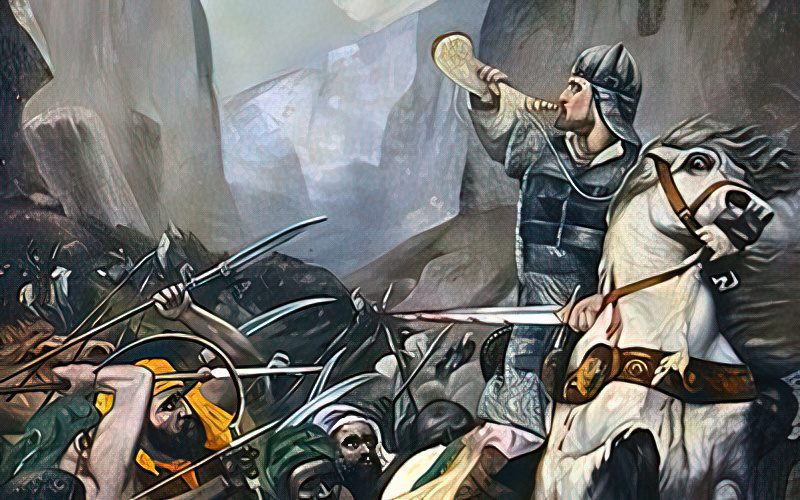The Durandal Sword of French Epic Poetry Is Basically Excalibur

What’s in this article?
Literature, especially epic poetry, is packed with legendary swords that carry themes of bravery and heroism as well as supernatural power. The Durandal sword of French epics is another of these swords.
Much like its English counterpart, Excalibur, Durandal is said to have mysterious origins, either brought to the west by Saracens of the east or created by Wayland the Smith, the mythical creator of other mythic swords such as Beowulf’s sword, Charlemagne’s Joyeuse and other swords used by Charlemagn’s paladins.
The Story of Durandal in La Chanson de Roland
La Chanson de Roland or The Song of Roland is an 11th century French epic poem that opens in the rolling landscape of the Pyrenees where Frankish Emperor Charlemagne calls his advisors to discuss the French occupation of Muslim Spain. Roland, the wielder of Durandal, suggests that his stepfather Ganelon should go discuss the terms of a peace treaty with the current Muslim ruler of Saragossa, Marsile.

Ganelon is understandably upset by this since it puts his life at risk. Sometime during the events of the poem, an angel delivers Durandal to Charlemagne, a sign of support from the divine for his campaign on its behalf. The famous sword was said to have a golden hilt, much like other medieval swords in epic poems. Charlemagne then hands it over to Roland who serves as his paladin and officer.
From here, we can see parallels between the Durandal sword and swords of Arthurian legend in the fact that it’s a magical sword given by a mythical creature (an angel or lady of the lake) to a hero (Arthur or Charlemagne) with a circle of noble fighters to serve them (the Knights of the Roundtable or paladins).
Roland wields Durandal in the Battle of Roncevaux Pass to help Charlemagne’s army escape from the Saracen forces and return to France. However, this meant that he would be left behind to fight alone. He is mortally injured in the battle and tries to destroy Durandal to prevent it from falling into Saracen hands but the sword could not be damaged.
Legends About Durandal Say It Created Roland’s Breach in the Pyrenees
Legends about Durandal stem from Roland’s battle in Roncevaux Pass. It is said that Roland’s Breach, a gap in the Pyrenees at the border between France and Spain, was created by Roland with just one cut from Durandal. Meanwhile, legends from locals of Rocamadour, a territory in Southwestern France, claim that Durandal is still embedded in the cliffs of the area from when Roland tried to destroy the sword.
Was the Durandal Sword Real?

The Durandal sword’s fanciful descriptions make it difficult to believe it’s 100% true. After all, the poem claims that Durnadal had, aside from a golden hilt, the tooth of Saint Peter, a piece of the Virgin Mary’s raiment, the hair of Saint Denis, and the blood of Basil of Caesarea. This may have been due to the middle ages’ fascination with holy relics.
But while Durandal, the legendary sword is likely to not be real, Durandal, the sword of Roland could be. It is said that the sword was obtained by Charlemagne in one of his campaigns in Toledo, Spain and that it was the sword of a Saracen prince. The idea that Durandal could be a war spoil would be consistent with the period and within the realm of possibility.
What Happened to Durandal?
It is unknown whether the real Durandal exists in some form, either as an artifact or as a medieval replica of the sword from the story. If the people of Rocamadour are to be believed, Durandal is embedded in its cliffs, its handle still sticking out of the stony edifice of the region. In modern times, though, Durandal serves as inspiration for video games like Honkai Impact 3rd and derivative literature based on western epic poetry.

Are There Replicas of the Durandal Sword?
Durandal sword replicas are rarely mass manufactured for sale due to the sword’s smaller buyer’s market. Should you come by one, expect to get a replica that is largely handmade due to the details that need to be incorporated into the sword, especially its gold hilt. We recommend getting a Durandal sword replica that is at least made of stainless steel to ensure realism and long term durability.
Conclusion
The Durandal sword’s status as a historical relic may be unclear, but its status as a cultural relic of medieval French epic poetry is undisputed. Its influence is felt in modern literature today, though not as popular as Excalibur, as well as newer mediums of art, making it a worthwhile sword to get a well-made replica of.




